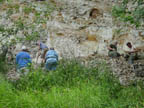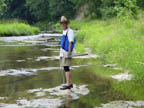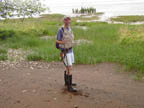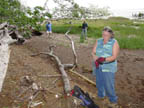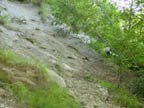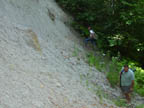Search and Rescue Report |
7/20/2006 to 7/23/2006 |
| Although I was unable to participate in Friday's activities here's a rundown of some of the fun they had. One of the visits was too a Keasey Formation (Eocene) site where the gastropod, Bathybembix, can be found. They are generally found in a very fragile state and need stabilized in order to keep the nacreous shell from flaking totally away and Bill found a real beauty. The next stop was another Keasey Formation site behind a local storage business in Vernonia. Not much was found but it's always a good site to check out when you're in the area.
I arrived a little late to Bill's house Saturday AM and missed the launch of the first trip of the day. Luckily a few others where running late as well. Soon Bill, Tim and myself were off the rock quarry to meet up with the others and collect in exposures of the Pittsburgh Bluff formation. The Pittsburgh Bluff formation is a late Eocene – mid Oligocene marine deposit. Collecting primarily consists of digging through mudstone deposits in search of concretions. With previous days temperatures in the 100's it was a relief to have some cloud cover for an hour or so while we dug away. With lunchtime getting close we headed back to Bill's house to see what was enclosed in the concretions we've found. We let Steve run the crack hammer and chisel to pop open the concretions. The primary fossil found at this site is the crab, Pulalius vulgaris, and I think we each found a few of various levels of quality. Also found where a few Pilumnoplax hannibalanus and one Portunities triangulum After lunch the next stop was to the world famous Mist Bluff site. Well the site may not be world famous but the crinoids that it had produced are. Unfortunately the lens is now covered in 15+ foot of river rock and no longer a viable locality to collect. The Mist Bluff site is a dangerous place. When working up against the wall you must keep a watchful eye out for falling debris. I was hoping to find a brittle stat on this trip but headed up river first to look for concretions. After popping a few I found one of the more unusual looking crabs from the area, the Carinaranina schencki. I headed back to the brittle star spot and started looking through material that has fallen off the wall. Pen found several nice echinoid spines as well as coral fragments. After a few minutes I headed down stream further to a small area that still produces crinoids. The quality is rather poor but they're still cool. Not finding any crinoids I headed up to the truck. I was worried about where we parked in a pasture full of cow and the land owner mentioned they liked to lean on vehicles. Well they didn't put any dents in the truck but for some reason they licked on all my windows, which were now slimed. The next stop was a stretch of the Nehalem River that we walk. Most of the members ended up searching for agate material while Bill, Andy and I headed downstream to look for concretions. Andy found a beautiful gastropod that's similar to the Bruclarkia oregonensis that is common in the Astoria Formation. I ended up with a few concretions that I took back to camp to pop. The next morning came much too early for all of us. Even with visions of fossils in my head it was tough getting up at 4am. An early start was needed in order to hit the low tide along the Columbia River. This site has exposures of Lincoln Creek and Astoria Formation. Most of what's found are concretions that have weathered out and are found as float. After a half mile hike to the banks the search was on. The shrimp claw of the Callianassa clallamensis is very common and I think we all found a few. I visited a small are of cobble and found two carapaces of a spider crab along with several river worn gastropods. One our way out we met up with Tim. He visited another location along the Columbia River that is an Eocene volcanic conglomerate but has concretions mixed in. It's reported to have 5 different species of crabs but all I've found to date is one small clam. Tim scored and found a very nice raninid that I'm looking forward to seeing once it's fully prepared. The next stop was a new location for me. It's a Miocene sandstone exposure where the crab Cancer wahkiakumensis has been found in the past. After an hour of searching I ended up with a partial clam and fragment of a gastropod that looked similar to the Musashia indurate that is found in the Astoria Formation. Aaron did find a few small concretions with partial crab claws, which may belong to the Cancer wahkiakumensis. The last stop for this trip was along the banks of Grays River to collect in the Lincoln Creek formation. Most of the concretions that we found contained mollusks but Aaron did find a very promising concretion that had a partial crab claw of a Pulalius vulgaris exposed. In all it was a great trip and thanks again Bill for allowing us to use your property for camping. NARG members: Andrew Bland, Andy Burkholz, Bill Sullivan, Aaron Currier, Tim Fisher, Steve Hetrick, Chuck Hunt, Rick and Peg Johnson, |
| ©2004 NARG - North America Research Group |







